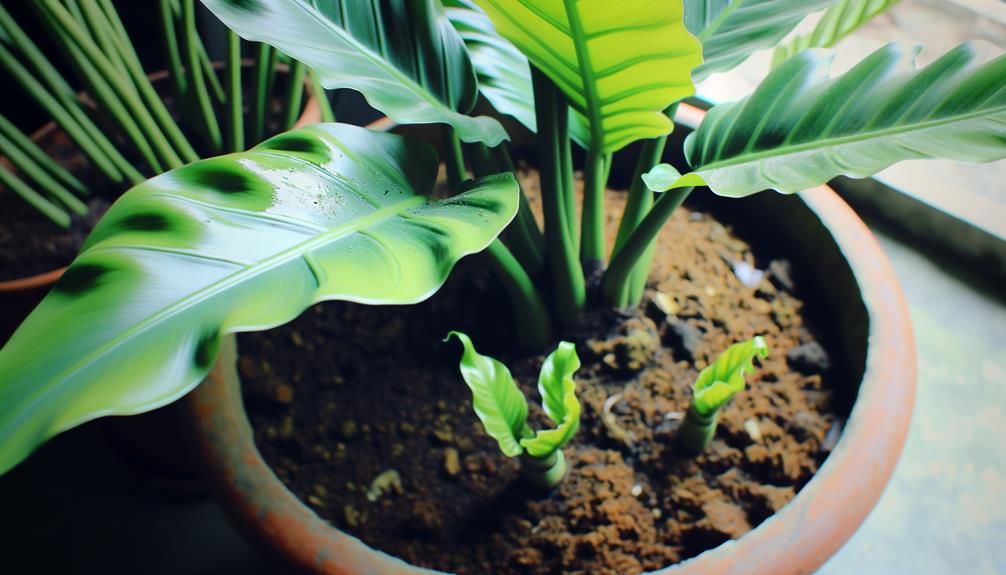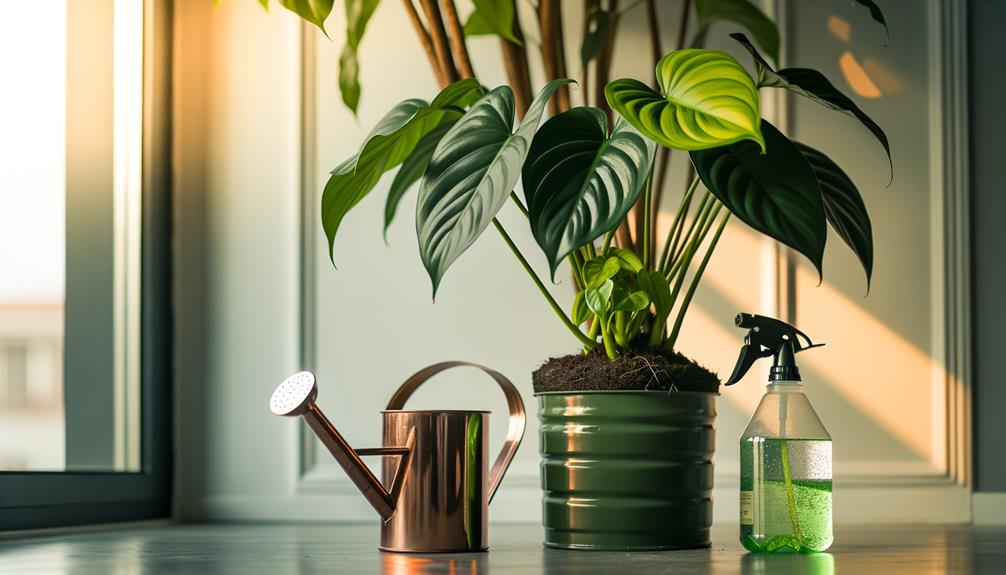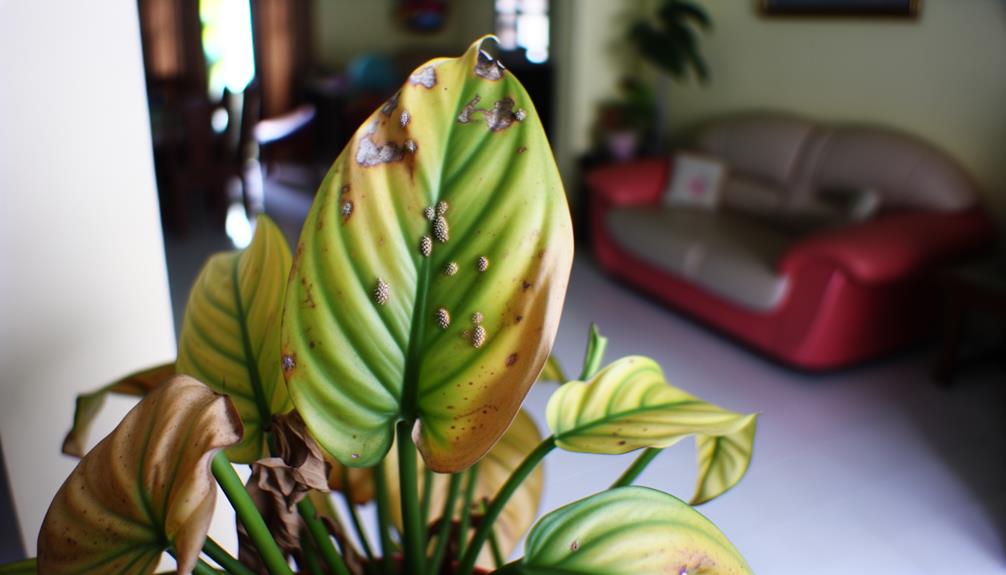What Is a Philodendron Xanadu Winterbourn?
The Philodendron Xanadu Winterbourn, developed in late 20th-century Australia through tissue culture methods, is a compact ornamental plant characterized by deeply incised leaves. Best growth conditions include temperatures of 65-75°F (18-24°C) and humidity levels above 60%.
Bright, indirect light is preferred while overwatering should be avoided. Fertilize bi-monthly during the growing season with a balanced 20-20-20 NPK formula.
Pruning is essential for maintaining shape and health, using sanitized tools. Seasonal care includes adjusting watering frequency and monitoring for pests like spider mites and mealybugs.
With proper care, this plant not only enhances decor but also improves indoor air quality. Discover more about its specific requirements and benefits.

Key Takeaways
- Philodendron Xanadu Winterbourn is a compact, ornamental plant developed in Australia.
- It features deeply incised leaves and a compact growth habit.
- Ideal growing conditions include temperatures between 65-75°F and humidity above 60%.
- Requires bright, indirect light and consistent moisture without waterlogging.
- Propagated via stem cuttings or division, enhancing indoor air quality and décor.
Origin and History

Philodendron Xanadu Winterbourn, a cultivar of the species Philodendron bipinnatifidum, was first developed in Australia during the late 20th century. This cultivar emerged from breeding programs aimed at producing compact, ornamental plants with enhanced aesthetic appeal.
The selection process focused on attributes such as controlled growth habit, dense foliage, and ease of maintenance, making it suitable for both indoor and landscape use. Initially, the propagation of Philodendron Xanadu Winterbourn was carried out via tissue culture methods to ensure genetic uniformity and disease resistance.
Over time, it gained popularity worldwide, particularly in horticultural and interior design communities. Its introduction to the global market has since positioned it as a preferred choice for both amateur and professional gardeners.
Unique Characteristics
The Philodendron Xanadu Winterbourn is distinguished by its uniquely lobed, deeply incised leaves, which contribute to its ornamental appeal.
Additionally, this cultivar exhibits a compact growth habit, making it suitable for both indoor and limited-space environments.
These characteristics set it apart from other philodendron species and hybrids.
Distinctive Leaf Shape
Characterized by deeply lobed, glossy green leaves, the Philodendron Xanadu Winterbourn exhibits a distinctive, sculptural foliage pattern that sets it apart from other Philodendron species.
Each leaf can grow up to 16 inches long and 12 inches wide, featuring 15-20 distinct lobes. These lobes are intricately cut and give the leaf a feather-like appearance. The glossy surface reflects light, enhancing the plant's aesthetic appeal.
Additionally, the leaves are thick and leathery, providing durability and a lush, tropical look. The venation is prominently visible, adding to the textural complexity.
These morphological characteristics not only contribute to its ornamental value but also indicate its robust adaptability to diverse indoor environments.
Compact Growth Habit
Beyond its distinctive leaf shape, the compact growth habit of the Philodendron Xanadu Winterbourn also enhances its suitability for both small indoor spaces and larger landscaped areas. Characterized by its dense, bushy form, this cultivar typically reaches a height and spread of 2-3 feet, making it an ideal choice for constrained environments.
The plant's robust, clumping growth pattern guarantees minimal maintenance while providing a lush, tropical appearance. In addition, the internodal spacing is relatively short, contributing to its dense foliage. This compact structure is advantageous for interior design applications, as it can easily fit into limited spaces without sacrificing aesthetic appeal.
Moreover, the consistent growth rate ensures year-round visual interest with minimal pruning requirements, maintaining a well-defined form.
Ideal Growing Conditions

Best growth for Philodendron Xanadu Winterbourn requires maintaining a temperature range between 65-75°F (18-24°C) with high humidity levels.
This tropical perennial thrives in environments with relative humidity exceeding 60%, which can be achieved through regular misting or using a humidifier.
The substrate should be well-draining, with a recommended pH level between 5.5 and 7.0, incorporating organic matter such as peat or compost.
Consistent moisture is essential, but it is crucial to avoid waterlogging to prevent root rot.
Additionally, the use of a balanced, water-soluble fertilizer, applied bi-monthly during the growing season, supports best development.
Proper ventilation is vital to mitigate fungal infections and pest infestations, ensuring healthy and robust foliage.
Light Requirements
The Philodendron Xanadu Winterbourn thrives in bright, indirect light, which simulates its natural understory habitat.
Direct sunlight should be avoided as it can cause leaf scorch and negatively impact plant health.
For best growth, maintaining a consistent lighting environment with diffused light is recommended.
Ideal Light Conditions
Philodendron Xanadu Winterbourn flourishes in bright, indirect light, which is crucial for maintaining its vibrant foliage and overall health. This plant benefits from light conditions that mimic its natural habitat, where it grows under the canopy of larger trees. Ideal light conditions contribute to robust growth and prevent leggy, weak stems.
- Light Intensity: Medium to bright, indirect light.
- Duration: Approximately 10-12 hours of light daily.
- Light Source: Natural sunlight filtered through sheer curtains or artificial grow lights.
- Light Consistency: Maintain consistent light exposure to avoid stress.
- Positioning: Place near east or north-facing windows for optimal light conditions.
Following these light requirements guarantees the Philodendron Xanadu Winterbourn remains healthy and aesthetically pleasing.
Avoid Direct Sunlight
Shielding the Philodendron Xanadu Winterbourn from direct sunlight is crucial to prevent leaf scorch and other sun-related damage. This tropical species thrives in bright, indirect light, simulating the dappled sunlight of its native understory habitat.
Prolonged exposure to intense sunlight can cause chlorosis, where leaves lose their green pigment, and necrosis, leading to tissue death. Ideal placement includes north or east-facing windows, where light is abundant but not harsh. If situated near a south or west-facing window, utilizing sheer curtains or blinds can diffuse the light.
Additionally, artificial grow lights with adjustable intensity can supplement natural light, ensuring optimal photosynthetic activity without risking photodamage. Regularly monitoring light conditions will sustain the plant's health and essentiality.
Watering Guidelines

Consistently maintaining appropriate moisture levels is crucial for the health of Philodendron Xanadu Winterbourn. Adequate watering practices promote optimal growth and prevent common issues such as root rot.
Here are key guidelines to follow:
- Frequency: Water the plant when the top inch of soil feels dry to the touch.
- Quantity: Apply water until it drains through the bottom of the pot to ensure uniform soil saturation.
- Seasonal Adjustment: Reduce watering frequency during the dormant winter months.
- Humidity: Sustain a humidity level of 60-70% for best results, using a humidifier if necessary.
- Drainage: Guarantee the pot has proper drainage holes to avoid water accumulation.
Following these guidelines will support the robust growth and health of your Philodendron Xanadu Winterbourn.
Soil Preferences
A well-draining, aerated soil mix rich in organic matter is necessary for the best growth of Philodendron Xanadu Winterbourn. This tropical plant thrives in a medium that retains some moisture while preventing waterlogging. Ideal soil composition includes a blend of peat, perlite, and pine bark to guarantee optimal drainage and aeration. The following table outlines the recommended soil components:
| Component | Percentage | Function |
|---|---|---|
| Peat | 40% | Retains moisture |
| Perlite | 30% | Enhances drainage |
| Pine Bark | 30% | Improves aeration |
Choosing a soil mix that aligns with these specifications will promote healthy root development and vigorous growth. Maintaining the correct soil environment is essential for preventing root rot and promoting nutrient uptake.
Fertilization Tips

To achieve peak growth and vibrancy, proper fertilization of Philodendron Xanadu Winterbourn is just as crucial as selecting the right soil mix. This tropical plant thrives when provided with a balanced, water-soluble fertilizer. Applying the fertilizer during its active growing seasons—spring and summer—ensures optimal nutrient absorption.
- Frequency: Fertilize every 4-6 weeks during active growth periods.
- Type: Use a balanced 20-20-20 NPK (nitrogen, phosphorus, potassium) formula.
- Concentration: Dilute the fertilizer to half the recommended strength to avoid root burn.
- Application: Apply directly to the soil, avoiding foliage contact.
- Observation: Monitor for signs of over-fertilization, such as leaf yellowing or browning.
Adhering to these guidelines will promote robust development and lush foliage.
Pruning and Maintenance
Effective pruning and maintenance of the Philodendron Xanadu Winterbourn involve adhering to specific best practices and understanding seasonal care requirements.
Regular removal of dead or damaged leaves promotes healthier growth and prevents disease.
Seasonal adjustments, particularly in watering and light exposure, are essential for maintaining plant vitality throughout the year.
Pruning Best Practices
When pruning Philodendron Xanadu Winterbourn, it is important to use sanitized, sharp tools to prevent disease transmission and make clean cuts. Proper pruning encourages healthy growth and maintains the plant's aesthetic appeal.
Key best practices for pruning include:
- Inspect for Dead or Diseased Leaves: Remove any yellowing, dead, or diseased foliage to prevent further spread of pathogens.
- Trim Overgrown Stems: Cut back stems that are excessively long to promote a more compact growth habit.
- Maintain Natural Shape: Prune in a manner that preserves the plant's natural form and symmetry.
- Seasonal Pruning: Conduct major pruning during the plant's active growing season for optimal recovery.
- Regular Inspection: Frequently check the plant for signs of overgrowth or disease, and prune as necessary.
These practices ensure a healthy, vibrant Philodendron Xanadu Winterbourn.
Seasonal Care Tips
Seasonal care for Philodendron Xanadu Winterbourn requires a careful approach to pruning and maintenance to achieve top plant health and aesthetic appeal throughout the year.
During spring and summer, conduct light pruning to remove any dead or damaged leaves, fostering vigorous growth and preventing disease.
In autumn, reduce watering frequency and refrain from fertilizing, as the plant's growth slows.
Winter care includes positioning the plant in a well-lit area away from drafts and maintaining a consistent temperature of 65-75°F (18-24°C). Pruning during this period should be minimal to avoid stress.
Regularly inspect for pests such as spider mites and scale, and apply appropriate treatments as needed.
Employ sterile pruning tools to prevent pathogen transmission.
Common Pests and Diseases

Philodendron Xanadu Winterbourn is prone to a variety of common pests and diseases, including spider mites, mealybugs, and root rot. These issues can have a significant impact on the plant's health, requiring prompt intervention. Spider mites cause stippling and webbing on the leaves, while mealybugs excrete honeydew, promoting sooty mold. Root rot, mainly caused by overwatering, results in blackened, mushy roots and stunted growth. Effective management involves regular inspection and appropriate treatments.
- Spider Mites: Look for delicate webbing and yellowing leaves.
- Mealybugs: Identify white, cottony masses on leaf connections.
- Root Rot: Ensure adequate drainage and avoid waterlogged soil.
- Fungal Infections: Apply fungicide and maintain air flow.
- Scale Insects: Spot small, brown, shell-like structures on stems and leaves.
Regular monitoring and early intervention are essential.
Propagation Methods
Successfully propagating Philodendron Xanadu Winterbourn primarily involves two methods: stem cuttings and division.
Stem cuttings entail selecting a healthy stem segment with at least two nodes and placing it in a well-draining substrate or water until roots form. Optimum conditions include indirect light and temperatures between 24-27°C.
Division involves separating the root ball during repotting, guaranteeing each new section has sufficient roots and foliage. This method is best performed in spring or early summer.
Both techniques require sterile tools to prevent disease transmission. Consistent humidity levels (60-70%) and proper watering are essential during the rooting phase.
Monitoring for common issues like root rot ensures successful propagation and healthy plant development.
Benefits as a Houseplant

One of the primary benefits of Xanadu Winterbourn as a houseplant is its ability to improve indoor air quality by efficiently filtering airborne toxins such as formaldehyde and benzene. This species, known for its broad, lobed leaves, contributes to a healthier living environment.
Additionally, its compact growth habit makes it suitable for various indoor spaces.
- Air Purification: Removes harmful chemicals from the air, promoting a healthier atmosphere.
- Low Maintenance: Requires minimal care, making it ideal for busy individuals.
- Aesthetic Appeal: Enhances interior decor with its lush, green foliage.
- Versatile Placement: Thrives in diverse lighting conditions, from low to moderate light.
- Humidity Regulation: Helps maintain indoor humidity levels, beneficial for skin and respiratory health.
This combination of attributes makes Philodendron Xanadu Winterbourn a valuable addition to any indoor environment.
Conclusion
Philodendron Xanadu Winterbourn, a cultivar recognized for its striking foliage and manageable size, offers both aesthetic and air-purifying benefits. Originating from Brazil, this plant thrives in indirect light and well-drained soil.
Importantly, studies indicate that indoor plants can reduce airborne dust by up to 20%, enhancing indoor air quality. Proper care involves regular watering, occasional pruning, and vigilance against pests.
Its ease of propagation further underscores its appeal as a resilient houseplant.






